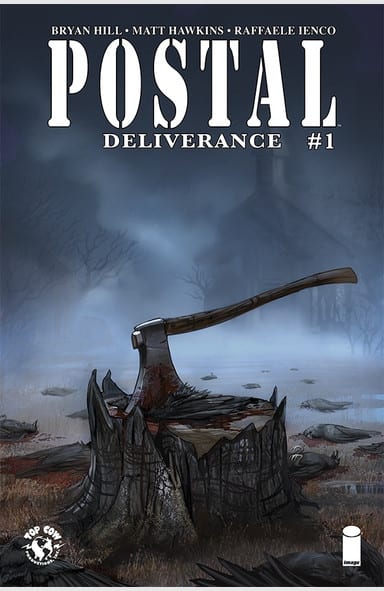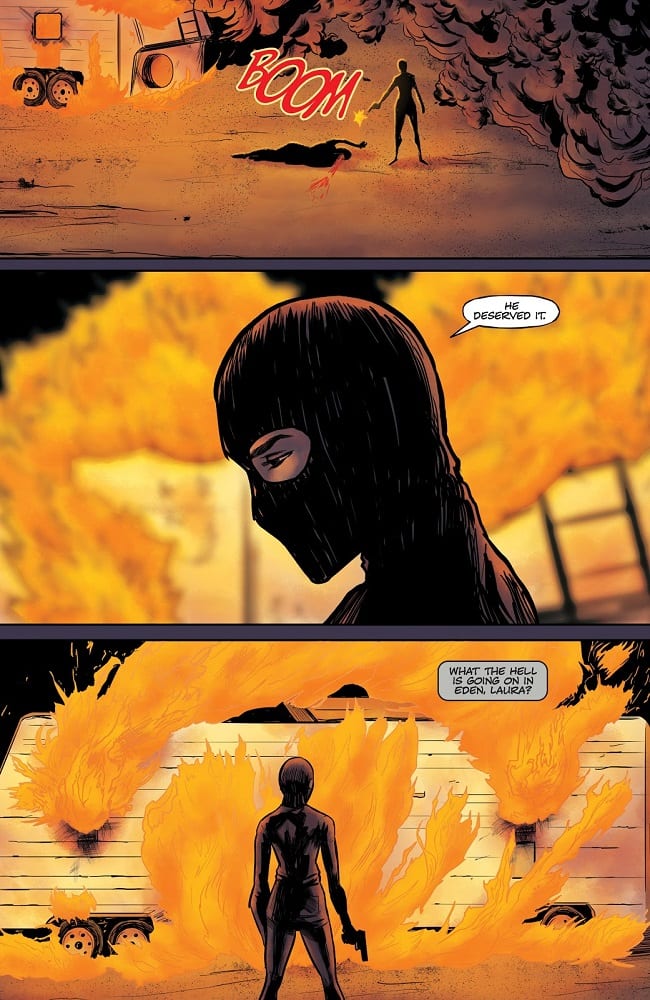On 3rd July the Top Cow imprint of Image Comics will release the first issue of the new arc of Postal. Writers Matt Hawkins and Bryan Hill will be reuniting for the first issue in over a year since the epilogue Postal: Laura was released in March 2018.
The new run is due to pick up directly from where the previous run left off, however the writer and creator Matt Hawkins has stated on Twitter that ‘you don’t actually have to read the first one to read this.’ This is good news for newbies to the comic but what have you missed?
Set in the town of Eden, a haven for criminals, the first arc introduces the characters and setting. It also has a well-constructed storyline that evolves the central characters through a series of moralistic dilemmas. The comic is packed with twists and turns and gob smacking moments. Here are five of the best bits from the initial Postal run.
Warning: The following contains Spoilers for the initial run of Postal

Bonding Over Violence
In the initial storyline, the town mailman and son of the Mayor, Mark Shiffron, is given a severe beating. Mark has Asperger’s syndrome, a weakness in his mother’s eye, and as such he is resigned to the mail house; put out of the way to keep him busy. Postal is primarily about Mark’s rise to power in the town of Eden and the character he is to become all stems from a confrontation in issue 4.
After being beaten by the followers of Isaac Shiffron (a much larger story) Mark asks for help from Maggie, a local waitress and pawn of the FBI. Together they confront his torturers. Mark lures the five people to a barn and confronts them, asking for an apology. They laugh in his face and threaten him with more violence. In steps Maggie, shotgun in hand, as protector and saviour.
This sequence is instrumental to the plot of the first arc because it lays the building blocks for Mark and Maggie’s relationship. From this moment onwards they are as thick as thieves. Hawkins/Hill manoeuvre the characters through the previous 3 issues, leading them to this exact moment. It portrays Mark’s inner strength and contrasts the way that he is seen with the way that he behaves.
It also demonstrates Maggie’s commitment to Mark. She is only just getting to know him but already she is willing to kill for him. She can see the future he has and is making a statement by being by his side.
This moment is a pivotal moment in their relationship but also cements their positions within the town of Eden.

I’m A Fire Starter
A number of the issues of Postal deal with difficult moral issues, often relating to horrible crimes. In issue 8 Maggie dispenses what she believes to be justice against a man accused of child murder. This issue revolves around the spread of rumours and the unjust corruption used to protect the guilty even at the risk of the innocent. Maggie is shown to be a violent fighter for the cause of innocence.
Johan is an ex-convict whose crime was theft however, when he was caught the body of a child was found buried in his garden. The authorities were never able to prove Johan had anything to do with the murder and he was adamant he didn’t kill the child. This didn’t stop the rumours or the constant beatings he received in prison.
When he was released he found sanctuary in Eden where Mayor Shiffron protects him, partly because that’s what Eden was designed for but also because she needs him to create a town wide surveillance network.
In issue 8 Maggie convinces Mark that Johan doesn’t deserve the protection of the Mayor or the town. This storyline further advances the relationship between Maggie and Mark. She pushes his boundaries to see just how much he will do for her. She is directing his actions which will lead, ultimately, to a confrontation with his mother.
But this issue also highlights Maggie’s staunch belief in right and wrong. The extreme’s that she goes to for justice, locking Johan in his caravan while she sets it on fire, demonstrate the strength of her beliefs. The writers want the reader to see what kind of world these characters live in. It is a world of protection and violence where one person’s ideas can mean life or death for others.
There is one panel in issue 8, drawn by Isaac Goodhart and colored by Betsy Gonia, that illustrates this concept perfectly. It is a headshot of a masked Maggie, surrounded by the flames of the caravan. She is cast mostly in shadow and she stares coldly at a body which is out of panel. The speech balloon hangs in the air behind her, a stark statement in the chaos: “He deserved it” she says with conviction. There is no reason to doubt her as she is portrayed steadfast within her belief.

This Is Your Home Now
As a companion piece to issues 4 and 8, issue 12 examines the lengths that Mark will go to in order to protect Maggie. A new resident to Eden causes trouble but just like Johan she is protected by the Mayor. The reasons for this protection are made clear to Mark but after the newbie, Molly, beats up Maggie to prove a point, Mark devises a plan to entrap her. The result is that Molly becomes locked in a cage, in a disused mine.
The contrast to the way that Mark deals with people and the way that Maggie, or his mother, deals with people is highlighted in this issue. Most of the town resort to violence to make their point or stake their claim but Mark is much more controlled and devious. He thinks about the big picture and crafts complex traps for people. The result is that he gets what he wants with the minimal amount of consequences. The moment in issue 12 where Mark locks Molly in the cage while distantly explaining her future life is a perfect snapshot of who Mark is.

Rowan
Issue 13 sees the start of a storyline where Eden goes to war against a white supremacist group. It is a violent, nasty war that results in a number of deaths. The introduction of the story however is an examination of redemption. The central character is Rowan; a once violent racist who severed time for manslaughter after dragging a young African American boy by a chain behind his truck.
On paper, Rowan is a nasty piece of work. However, Bryan Hill manages to get the reader to empathise with Rowan. Throughout the issue Rowan’s story is revealed and he receives a range of reactions from the other characters. Hatred, anger, indifference and pity. These emotions flood the comic as Hill forces the reader to question the notion of forgiveness and redemption. Who has the right to be forgiven and who can do the forgiving?
Issue 13 of Postal is a powerful look at hate crime and the everlasting consequences. It is one of the best issues of the entire run and worth reading. Hill and Goodhart deal with a very difficult subject in a mature and thought provoking way.

This Is The End?
The final monumental moment of the first arc comes at the very end, almost. Issue 25 picks up after the final confrontation of the Shiffron’s and sees Laura reveal her final secret to Mark. The series started with the death of Marks sister and it ends with him finding out about the death of a brother he knew nothing about. The story, involving human sacrifice, illustrates the insanity at the heart of Eden and how it affected Laura from the very beginning. She knows that she has done wrong but can’t get passed the hope that what she did was, ultimately, worth it.
In the final sequence of the comic Laura passes the baton of responsibility for Mark to Maggie then leaves Eden. As she ventures into the empty land around the town the color fades from the landscape, a bright, yellow light fills the horizon and Laura puts a gun to her head.
The atmosphere created by K. Michael Russell’s colors is outstanding. It produces a sense of a new dawn: as if the long night has finally ended and something new is coming. It is symbolic of Laura’s decision to commit suicide and leaver her son, Mark, to take over. The sequence has a warming glow but it doesn’t quite reach Laura who is drained of color. She sits in a field, alone and determined.
On the final page Mark makes an appearance and almost begs for Laura to stop. They have come so far; their relationship has changed dramatically because of the violence surrounding them. But at the end, it comes down to a son asking his mother to stay with him.
The scene is touching yet tense. Even in the final panel where all the color has faded, and the landscape is fading to white, the reader does not know the outcome of their meeting. Does Laura killer herself or not? At this point the answer is irrelevant. The moment is about the change, about the dawn of a new day and about the growth of Mark. He is no longer the helpless boy introduced in the first issue.

Postal: Deliverance picks up after these moving scenes with the next chapter in Marks life. He is running the town of Eden and must face new problems and dilemmas. Where the series will go is anyone’s guess but one thing is for certain, based on the first arc, anything is possible. With Postal expect action, violence, character, and drama but also be prepared for your beliefs to be challenged.
Postal takes risks. This is one of man reasons to read it when it returns.
Did you have any favourite moments from the first run of Postal? Why not let us know in the comments below.

